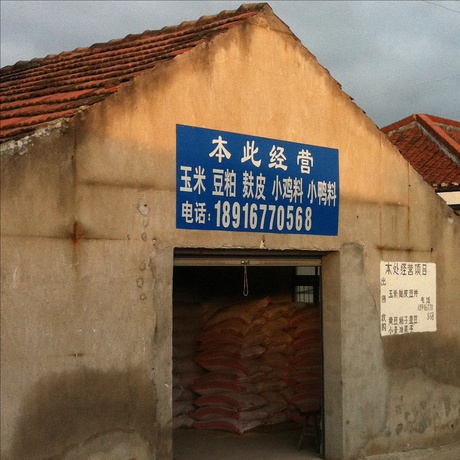Dialectal interference in Shanghai
« previous post | next post »
Here's a photo of a warehouse on Chongming Island, at the northern edge of Shanghai, which deals in various agricultural products, as listed on the two signs:

(Source)
At the top of the large blue sign above the door, it reads:
běn cǐ jīngyíng 本此经营
("this here deals in"), where cǐ 此 ("here") is an erroneous character
At the top of the white sign to the right of the door, it reads:
běn chù jīngyíng xiàngmù 本处经营项目
("this place deals in [these] items"), where chù 处 is the correct usage
In Wu topolect, to which Shanghainese belongs, the following pronunciations pertain:
此 tshr (T2); Middle Sinitic /t͡sʰiᴇX/
处 tshr (T2); Middle Sinitic /t͡ɕʰɨʌX/
Thus we can see that the pronunciation of 此 and 处 in modern Wu is identical, which would have led to the confusion between the two characters on the blue and white signs.
[Thanks to Joel Martinsen]
B.Ma said,
October 5, 2016 @ 1:36 am
How come the post isn't titled "topolectal interference"?
Victor Mair said,
October 5, 2016 @ 7:18 am
@B.Ma
Thanks for the good question. I was actually secretly hoping that someone would ask that.
As a matter of fact, I came very close to titling this post "Topolectal interference in Shanghai", but at the last minute decided not to because of the following considerations:
1. Since the warehouse is on Chongming, which is a relatively isolated, rural island on the edge of Shanghai, I suspected that its location and nature might make it more susceptible to Wu pronunciation than central Shanghai, which increasingly follows Mandarin pronunciation norms, in which case the difference between Chongming and central Shanghai could be said to be dialectal.
2. "Dialect interference" is an established term for the phenomenon I wished to describe.
Jichang Lulu said,
October 5, 2016 @ 4:53 pm
This is very interesting. Two minor remarks:
The MC reconstruction given for 处, with 'rising' tone (上, tone B, indicated by an X in the transcription and reflected as MSM tone 3), would be relevant to the verb. For the noun, as used in the sign, the tone is 'departing' (去, tone C), which in that type of transcription would show up as a (superscript) H resulting in MSM tone 4. That distinction is meaningless in Shanghainese though, since both 处's are pronounced the same there (quite analogously to the 买卖不分 phenomenon).
Chongming belongs to Shanghai municipality (as a county since the 60s, and since this year as a district), but it has a distinctive identity. It's known for supplying Shanghai with rice wine, taxi drivers (崇明的哥 Chóngmíng dìgē), and also has its own topolect. Chongming has eight citation tones in monosyllables (against five in Shanghai). If I'm not mistaken, 此 and the noun 处 are actually not homophonous in Chongming if pronounced in isolation, unlike in Shanghai. Again, this distinction becomes irrelevant after 本, since I think tone sandhi would give the same output in both cases.
A 28k-entry Chongming dictionary was published two years ago, but I haven't seen it.